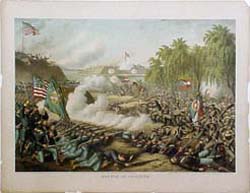Civil War Battles |
Colonial Wars |
American Wars |
Link To This Page — Contact Us —
The Battle of Corinth (First)
April 29-June 10, 1862 in Corinth, Mississippi
 |
|||||||||||||||||||||
|
At the end of April, the Union army of almost 125,000 men, led by Maj. Gen. Henry Halleck, set out from Pittsburg and Hamburg Landings towards Corinth. A Confederate force of about half that size, under Gen. P.G.T. Beauregard, waited for them, behind 5 miles of earthworks. Both commanders knew the importance of the coming battle. Halleck claimed that the railroad centers in Richmond, Virginia, and Corinth were "the greatest strategic points of the war, and our success at these points should be insured at all hazards."
It took Halleck a month to travel the 22 miles to Corinth. The route crossed a series of low ridges covered with dense forests and cut by stream valleys and ravines. Moving his army through rugged country while keeping it aligned along a 10-mile front was slow and difficult work. The weather was bad and there was not very much good water for the troops to drink. This made dysentery and typhoid very common among his men.
By May 4, the Union army was within 10 miles of Corinth and the railroads. The Confederates began a series of small scale attacks, keeping up a nearly constant harassment. Halleck, cautious by nature, established an elaborate procedure to protect his army as they advanced. As the troops moved up to a new position, they worked day and night digging trenches. As each line of earthworks was finished, the men advanced about a mile and then started digging a new line of trenches. Eventually there were 7 progressive lines and about 40 miles of trenches.The Confederates waiting in Corinth were well aware of Halleck's slow, but constant, advance.
On May 21, Beauregard planned a counterattack, an attempt to draw the enemy out of his entrenched positions and separate his closed masses for a battle. The gamble came to naught because of delays in getting the troops in position to attack.
By May 25, after moving 5 miles in 3 weeks, Halleck was in position to lay siege to the town. The long Union line was entrenched on high ground within a few thousand yards of the Confederate fortifications. From that range, Union guns shelled the Confederate defensive earthworks, and the supply base and railroad facilities in Corinth. Beauregard was outnumbered 2-to-1. The water was bad. Typhoid and dysentery had felled thousands of his men. At a council of war, the Confederate officers concluded that they could not hold the railroad crossover.
On May 29, during the evening, Beauregard saved his army by a hoax. Some of the men were given 3- days' rations and ordered to prepare for an attack. As expected, 1 or 2 went over to the Union with that news. During the night, the Confederate army moved out and evacuated Corinth, withdrawing to Tupelo. They used the Mobile & Ohio Railroad to carry the sick and wounded, the heavy artillery, and tons of supplies. When a train arrived, the troops cheered as though reinforcements were arriving. They set up dummy ("Quaker") guns along the defensive earthworks. Camp fires were kept burning, and buglers and drummers played. The rest of the men slipped away undetected.
On May 30, when Union patrols entered Corinth, they found the Confederates gone. The Federals had consolidated their position in northern Mississippi. The Battle of Corinth (First) was also known as the Siege of Corinth.
